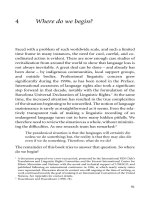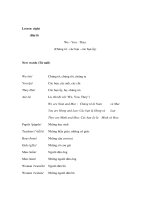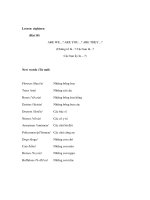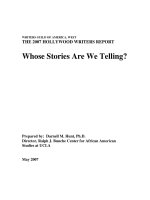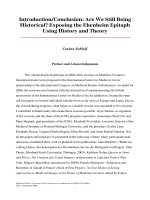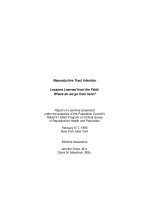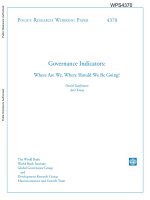1 fracture related infection where are we now
Bạn đang xem bản rút gọn của tài liệu. Xem và tải ngay bản đầy đủ của tài liệu tại đây (4.48 MB, 28 trang )
UNIVERSITY OF MEDICINE & PHARMACY AT HO CHI MINH CITY
INTERDISCIPLINARY CME CONGRESS
Fracture – Related Infection
Where are we now?
Do Phuoc Hung, M.D, Assoc.Prof.
Department of Orthopaedics and Rehabilitations
Ho Chi Minh City, September 16th, 2023
Why are we here? What’s the matter?!
2
How significant is definition of FRI?
• Accurate diagnosis: critical for preventing poor
outcomes
• Limitations with gold standards: further
complicate diagnosis and management process
3
Which condition does
‘Fracture – Related Infection’ (FRI)
most likely refer to?
A. Surgical Site Infection (SSI)
B. Infected Nonunion/Septic Nonunion
C. Infection After Fracture Fixation
D. Posttraumatic Osteomyelitis
4
Surgical Site Infection (CDC)
Surgical site infection = infection of the incision / organ / space
that occur after surgery
Source: CDC – National Healthcare Safety Network (NHSN) 2023
5
Diagnostic Criteria – SSI
NHSN orthopedic procedure
only ORIF
• > 90 days?
• Other procedures than ORIF? No surgery?
Source: CDC – National Healthcare Safety Network (NHSN) 2023
6
Osteitis or Osteomyelitis?
• Mostly exogenous, but remember
hematogenous!
• Difficult to distinguish
• More important is the presence of
bacteria at fracture site !
Source: Fang et al. J Orthop Surg 2017;25(1):2309499017692712. Depypere et al. Clin Microbiol Infect 2020;26(5):572-578
7
What is FRI?
“... a more comprehensive term ... encompassed infections with and without implants
& included infection of all parts of the bone (cortical, medullary, epiphyseal).”
FRI = all infections occur in the
presence of a fracture, including:
– Early infection around fx implants
– Infection in fx with no internal fixation
– Infected nonunion
– Haematogenous infection
arising after fx healing (?)
Source: Metsemakers et al. Injury 2018;49(3):505-510. McNally et al. EFORT Open Rev 2020;5(10):614–619
8
Case presentation
• Male, 23 years old
• ORIF right proximal humerus fx 6 months ago
• Swelling, warm, redness, painful scar for 1 month,
unconfirmed purulent drainage, fever (-)
• Exam: tenderness (+), restricted shoulder ROM
• WBC 8.32 G/L, Neu 58.7%, CRP 13.1 mg/L
Can FRI be diagnosed at this time?
9
Clinical Diagnosis – FRI
Confirmatory Criteria ≥ 1
• Fistula, sinus or wound
breakdown (communication
to bone / implant)
• Purulent drainage or
presence of pus
Note: presence of pathogens via
culture is NOT an absolute
requirement, esp. in chronic
antibiotic-use cases
Source: Govaert et al. J Orthop Trauma 2020;34:8-17
10
Case presentation
• Male, 23 years old
• ORIF right proximal humerus fx 6 months ago
• Swelling, warm, redness, painful scar for 1 month,
unconfirmed purulent drainage, fever (-)
• Exam: tenderness (+), restricted shoulder ROM
• WBC 8.32 G/L, Neu 58.7%, CRP 13.1 mg/L
How can we confirmed the communication
between the infection & fracture/implant?
Aspiration? Operation? or Else?
11
Clinical Diagnosis – FRI
Suggestive Criteria ≥ 1
New discharge 2 wks
after ORIF tibia fx
Swelling 2m after
ORIF patella fx
Clinical signs
Local: swelling / temperature /
redness / pain (without weight
bearing, over time, new)
Persistent / / new wound
drainage (beyond first few days
postop, without explanation)
Swelling 2m after
ORIF femur fx
New joint effusion in fracture
patients (implant penetrates joint
capsule / intra-articular fractures)
Systemic: fever (≥ 38.3oC)
Source: Govaert et al. J Orthop Trauma 2020;34:8-17
12
Clinical Diagnosis – FRI
BUT ≥ ???
Suggestive Criteria ≥ 1
Laboratory signs
Only in case of secondary rise
(after initial decrease) or
consistent elevation over time
AND after exclusion
other infectious focci or
inflammation processes
WBC
• Different cut-offs:
– CRP: 5 – 10 mg/L
– WBC: 9.15 – 10.2 G/L
– ESR: 11 – 30 mm/h
ESR
CRP
Insufficient to confirm or rule out
Cautious when interpreting results
Source: Govaert et al. J Orthop Trauma 2020;34:8-17. van den Kieboom et al. Bone Joint J 2018;100-B:1542-1550
13
Clinical Diagnosis – FRI
PO 8m
Suggestive Criteria ≥ 1
Radiological signs
Bone lysis (at fracture, around
implant)
Implant loosening
PO 1 yr
Sequestration (occurring over time)
Failure of progression of bone
healing (non-union)
Periosteal bone formation (≠
fracture site / in case of a
consolidated fracture)
Source: Govaert et al. J Orthop Trauma 2020;34:8-17. Bosch et al. Clin Transl Imaging 2020;8:289-298
14
Come back to the case
• Male, 23 years old
• ORIF right proximal humerus fx 6 months ago
• Swelling, warm, redness, painful scar for 1 month,
unconfirmed purulent drainage, fever (-)
• Exam: tenderness (+), restricted shoulder ROM
• WBC 8.32 G/L, Neu 58.7%, CRP 13.1 mg/L
• Imaging ...
Suggestive criteria (+) Then, what should we do?
15
Diagnostic Flowchart
Source: Govaert et al. J Orthop Trauma 2020;34:8-17
16
Post-op Diagnosis – FRI
Confirmatory Criteria ≥ 1
• Culture: phenotypically
indistinguishable pathogens
from ≥ 2 separate deep tissue
/ implant specimens
• Histopathology:
– Microorganisms in deep tissue
specimen
Preferably 5 samples:
• Ideally from implant – bone interface
• Avoid superficial, skin, or sinus tract samples
• By separate clean, unused instruments
• ‘No touch’ the skin
• Put in separate pieces of gauze
• Transferred in separate containers
– > 5 polymorphonuclear
neutrophils via high-power field
(Govaert et al, 2020)
Source: Govaert et al. J Orthop Trauma 2020;34:8-17
17
Post-op Diagnosis – FRI
Implant Sonication
Confirmatory Criteria ≥ 1
• Culture: phenotypically
indistinguishable pathogens
from ≥ 2 separate deep tissue /
implant specimens
• Histopathology:
– Microorganisms in deep tissue
Only in chronic / late-onset cases (nonunion)
specimen
– > 5 polymorphonuclear
neutrophils via high-power
(x400) field (Govaert et al, 2020)
Source: Govaert et al. J Orthop Trauma 2020;34:8-17. Morgenstern et al. Bone Joint J 2018;100-B:966–972
18
Post-op Diagnosis – FRI
Suggestive Criteria
In combination with other
suggestive criteria
there should be a high suspicion
of FRI
Culture: pathogenic organism from
a single deep tissue / implant
specimen
Source: Govaert et al. J Orthop Trauma 2020;34:8-17
19
The patient underwent surgery
20
Source: Onsea et al. Injury 2022;53(6):1867-1879
21
Timing Classification of IAFF
• Early (< 2 weeks):
– Highly virulent organism
– Biofilm: may ‘immature’
– Bone: ‘inflammatory’ or ‘soft callus’
• Delayed (2 – 10 weeks):
– Less virulent organism
– Biofilm: ‘mature’, more resistant
– Bone: ‘hard callus’
• Late (> 10 weeks):
– Low virulent organism
– Periosteal new bone formation,
involucrum
Source: Metsemakers et al. Injury 2018;49(3):511-522
22
Classification of Osteomyelitis
• 12 clinical stages
• Guide treatment
strategies
• NO correlate with
prognosis
• NO reference to soft
tissue coverage &
microbiology
Source: Cierny et al. Chin Orthop Relat Res 2003;414:7-24
23
The new BACH Classification
• High reproducibility
• Can be applied accurately
by users with a variety of
clinical backgrounds
• Need further evaluation for
prognosis & management
Source: Hotchen et al. Bone Joint Res 2019;8(10):459-468
24
The Joint-Specific BACH classification
25

